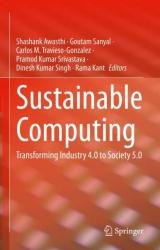 Название: Sustainable Computing: Transforming Industry 4.0 to Society 5.0
Название: Sustainable Computing: Transforming Industry 4.0 to Society 5.0Автор: Shashank Awasthi, Goutam Sanyal, Carlos M. Travieso-Gonzalez
Издательство: Springer
Год: 2023
Страниц: 352
Язык: английский
Формат: pdf (true), epub
Размер: 55.6 MB
This book presents recent advancements in Industry 4.0 and addresses how these can be useful in achieving sustainable solutions in Society 5.0. The book also serves as a reference for developing sustainable engineering solutions to various socio-economic and techno-commercial issues. The book is meticulously structured into two sections: Section I sheds light on fundamentals, nitty-gritties, and principles of technological innovations and advancement in Artificial Intelligence, Cloud Computing, industrial Internet of Things (IIOT), and Society 5.0, whereas Section II covers viable engineering solutions developments for revamping Industry 4.0 to Society 5.0. Overall, the authors aim to show how technological advancements can be used to address social issues and improve society.
The wireless communication industry is facing new challenges due to constant evolution of new standards (2.5G, 3G, 4G and 5G), existence of incompatible wireless network technologies in different countries inhibiting deployment of global roaming facilities and problems in rolling out new services/features due to widespread presence of legacy subscriber handsets. Software-defined radio (SDR) technology promises to solve these problems by implementing the radio functionality on a generic hardware platform.
Wireless sensor networks refer to networks that are geographically dispersed and have dedicated sensors that monitor and record visual changes and environmental conditions. The data which is sensed is then transmitted to the central area, which is usually the base or control station. Even though sensors are used for specialized services, plenty of research has taken place in the area of WSN recently. A sensor network consists of numerous nonlinearly arranged self-governing sensor devices. These devices direct the sensed instruction to the node and make the optimum usage of the obtained information. Initially, due to the increased cost and limitations of wireless sensors, the use was limited. The recent advancements and reduced cost of wireless sensors have increased its field of application. The sensor network consists of various detection channels which are nothing but lightweight, portable, and small-sized sensors. Each sensor node has a transducer that senses a few physical parameters and produces signals based on these parameters. It also consists of a small computer which computes and stores the observed data and a transceiver that receives commands from the control station.
Big Data is data that is too massive, complicated, and dynamic to be captured, stored, managed, and analysed using traditional data methods. We need this data to make informed decisions with real-time dynamic updates in a business so that the leaking losses are minimized and the business runs to its optimum. The ultimate vision is to move towards machines that discover and an Internet that learns.
Hadoop has become almost synonymous with Big Data, leading to social analytics and Algorithmic Approach to Business. Apache Hadoop is a collection of open-source software utilities that provides a software framework that is designed with the objective of having less expensive Data Storage that would allow the firms in carefully storing, efficient handling, and analysing the data. Hadoop is designed with Master–slave Architecture for data storage and processing. This architecture provides a well-grounded, flexible, and distributed computing framework. Hadoop Distributed File System (HDFS) is the main data storage system used by Hadoop applications. It utilizes a Data Node and Name Node (master–slave) architecture to execute a distributed file system that allows high-performance access to data across highly reliable and scalable Hadoop clusters.
Deep Learning is an integral part of concept machine learning, which is based upon artificial neural networks (ANN). Initial research indicates that a linear perceptron cannot be used as a ubiquitous classifier but that a network with function of execution, having non-polynomial nature, and with unbounded width, a hidden layer can be used. Deep learning is the latest aberrant that takes account of a bounded-sized unbounded number of layers, allowing optimization for a functional application while maintaining a theoretical unique approach under mild conditions. Its layers can be heterogeneous as well as indifferent from the biologically informed connection models for good understandability, trainability, and the sake of performance.
Скачать Sustainable Computing: Transforming Industry 4.0 to Society 5.0